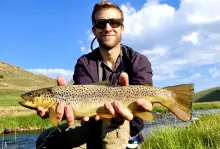Make sure your waders are suited for winter fishing and remember warm socks – as well as a local guide. Then you are ready for the north Atlantic fishing paradise.
The cliffs rise steeply hundreds of feet high and snow covered along the valley. Northern fulmars are sitting on rock shelves on the dark mountain side or flying on the upwind along the ridges. And in the valley runs a crystal clear stream, which holds schools of shiny, hunting sea trout.
We walk towards
the coast in Saksundalen and present our flies to the hungry but shy fish. A large sandbar is dry at low tide, and along it runs the brackish water that we follow, while the fly rods work steadily.
Suddenly there is tension in the line as one of the bright trout has taken the fly, a small Copper Bully. It fights heroically with several small runs, but must eventually give up. The 37 centimeter (15") fish is brought home for the frying pan. A fine fish that is well above the minimum size of 30 centimeters (12") here in the Faroe Islands.
The winter fishing
for sea trout is quite good on the Faroe Islands. Most of the fish are not trophy size, but they fight with a ferocity that is worthy of much larger fish. The largest fish caught this season is about 60 centimeters or just shy of 24".
The fishing often takes place in the bottom of fjords or in estuaries where one of the numerous small streams empty into the ocean.
The surroundings
are extremely beautiful, and in some places – like in Saksun – you almost feel placed in a backdrop that resembles an adventure by Tolkien. Only dwarfs, wizards and elves are missing.
On the mountain sides, the hardy sheep move freely, and here and there are also flocks of starlings and some geese.
The infrastructure
on the islands is excellent, and it's easy to get from fishing spot to fishing spot using good roads, bridges between many islands and tunnels through the steepest mountains.
However, it cannot be recommended enough to use a guide with local knowledge when you go fishing. It simply makes the difference between success and failure, as the guide can advise on which places fishing is best in relation to wind, weather and tide.
The weather can be very fickle
– it changes from sun and quiet to stormy gale with snow or hail showers in minutes – and back again equally fast. A local saying goes: "If you don't like the weather, just wait 5 minutes".
It is therefore advisable to take both class 5 and class 7 rods if you are a fly fisherman. Light rods for mild weather and a heavier rod to fight the wind.
Spinning and deep-sea fishermen, of course, also have great opportunities, whether the prey is trout, saithe or herring shark. The latter, which can weigh up to 150 kilos, are serious business, and are of course caught on very heavy gear.
In any case,
a trip to the Faroe Islands can be highly recommended – even in January – and although the weather can be harsh, the Gulf Stream will provide mostly mild winters.
If you don't like the weather, just wait 5 minutes
Make sure you have warm clothes
and waterproof waders – then you are ready to fight the small silver bars in the fishing paradise. In addition to that, the adventure can be reached after a short flight of a couple of hours from Copenhagen and at a very reasonable price. In my opinion there isn't much to consider.
The Faroese nature can be challenging, but is wonderful and breathtaking – also for those who travel outside the traditional tourist season.
Saksun – fishing in picturesque settings
The fishing in Saksun takes place in a magnificent setting. In the fjord one can fish without a license, but in the river that runs out into the fjord you must ask the farmer for permission, and maybe you will have to pay to fish.
You can't drive the last bit down the hill towards the fjord. You can park the car at the top next to a red house with high white foundation, and walk the 15 minutes down the hill. Be sure to get outside the estuary and into the fjord before fishing begins.
You can also rent the red house with the high white foundation. Here are beds for at least 6 people, bath, toilet, kitchen with all facilities – even basic foods like spices etc.
There is shopping in Oyrarbakki, where several shops are found.
The house is located in the middle of Saksun, which is one of the largest tourist attractions in the Faroe Islands. That is unfortunately reflected in the price, which is DKK 900 per day and DKK 600 in cleaning fee (app. 140 and 100 US$). The price can be negotiated for several days. On our trip in January, which is definitely out of season, we could get 6 days for 3,500 DKK (about 535.- US$).
The fishing is less than a 15 minutes walk from the house.
The house can also be rented through AirBnB.
Our guide was Simon Nielsen – Danish but Faroese married. Simon knows all the good spots in the Faroe Islands and catches many fish – both on spin and on fly.
House
Torgerd Dam
Torgerddam@hotmail.com
+298 536666
Guide
Simon Nielsen
senvirki@gmail.com
+298 790908
Kim Conrad Petersen
- Log in to post comments




























